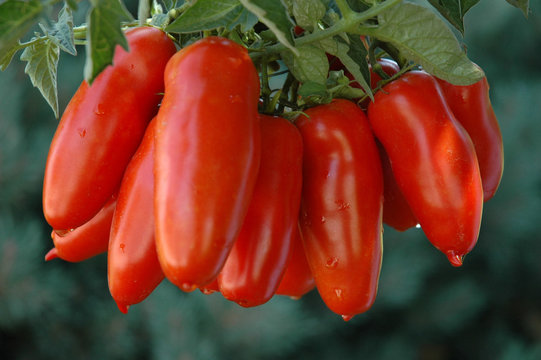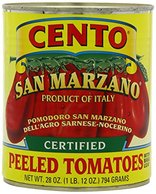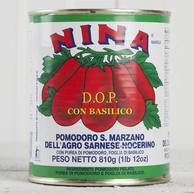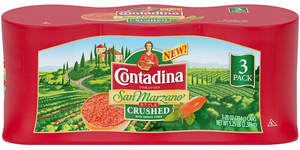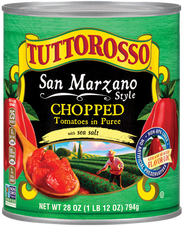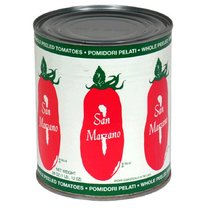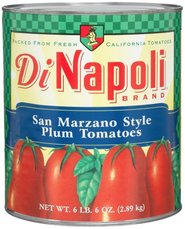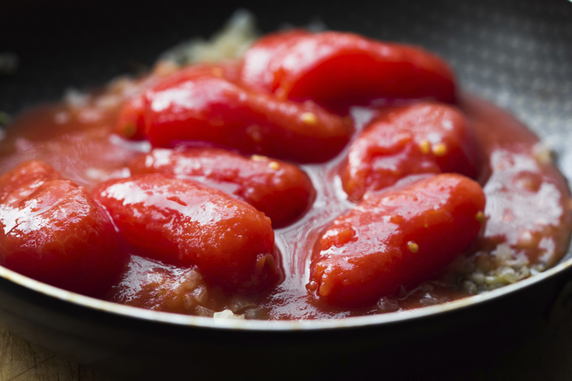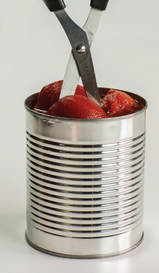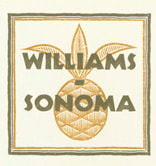|
San Marzano tomatoes are the holy grail when it comes to sauce tomatoes. They often cost twice the price of other canned tomatoes, which is the reason why there are many counterfeit, bogus tomatoes in cans labeled San Marzano, or "San Marzano style". Experts say that up to 95% of the tomatoes labeled "San Marzano" are tomatoes grown in other regions of Italy or other countries. The Italian Mafia and other unscrupulous organizations will place lesser quality tomatoes into cans and label them as San Marzano, when in reality they are a mixture of less sweet, less meaty tomatoes. In was in 2011 that the president of Consorzio San Marzano (Consortium for the Protection of the San Marzano Tomato Dell'agro Sarnese Nocerino) said that only five percent of tomatoes marked as such are certified, D.O.P. San Marzano tomatoes. San Marzano tomatoes are elongated plum tomatoes that by decree, must be grown in Agro Sarnese-Nocerino, an area surrounding Mount Vesuvious near Naples. When they are canned, they come with a D.O.P.-Denominazione d' Origine Protetta (literally “Protected Designation of Origin”) emblem on the label, marking their authenticity. This is the same type of certification that ensures the authenticity of other Italian products, such as Parmigiano Reggiano, Prosciutto di Parma or Balsamic di Molena. To ensure you are getting San Marzano tomatoes, make sure that the can has one of the following on it: "Certified San Marzano", the DOP emblem, or the words "San Marzano dell'Agro Sarnese-Nocerino". The ingredients should list "whole (or peeled) San Marzano tomatoes". Some producers also include a statement something like, "San Marzano tomatoes (DOP-protected designation of Origin) are only cultivated in 41 approved municipalities, from San Marzano seeds, within the Sarno River valley surrounding Naples (or 'near the slopes of Mount Vesuvious'), in the Campania region." If the label says, "Grown in the USA", steer clear. Certified Authentic San Marzano Tomatoes The Phony Stuff 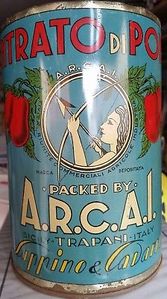 A 1940s era canned tomato that might be San Marzano A 1940s era canned tomato that might be San Marzano Compared to the Roma tomato, San Marzano tomatoes are thinner, a bit longer and pointed at their ends. The thicker, meatier flesh has fewer seeds and is fantastic for making sauce. The taste is also stronger, sweeter and less acidic. (I've had pizza from one local chic, wood oven pizzeria who claimed the tomatoes in their sauce were San Marzano, but the amazingly high acidic level burned my lips. I called BS.) As many know, the tomato itself was imported to Europe after being discovered in the New World. Its first culinary appearance was in a 1692 cookbook as a base for a sauce. The San Marzano itself doesn't show up until much later, in a tomato manual published in 1940, the San Marzano is listed as a "recent cross" between the Re Umberto and Fiaschetto varieties. 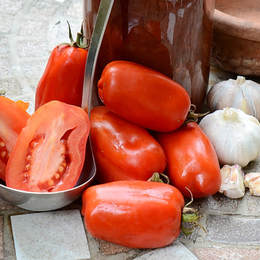 The San Marzano vines are indeterminate type, and have a somewhat longer season than other paste tomato varieties, making them well suitable for warmer climates. Indeterminate tomato plants will keep producing fruit as long as the warm, sunny weather lasts, whereas determinate varieties produce only a set number of fruit on shorter plants, and then die. Many heirloom tomatoes are indeterminate type (like the varieties I grow, producing 8' plants). San Marzano is an "open-pollinated", heirloom variety that breeds true from generation to generation, making seed saving practical for the home gardener or farmer. You can't save seeds from hybrid tomatoes because they cross-pollinate, which results in pot-luck tomatoes appearing on the vine. If you can get some authentic, D.O.P. San Marzano tomatoes while in Campania, save some seeds to plant in your home garden, although they won't have the D.O.P. designation, they will be fairly close the what is grown in Campania. (Of course, you can't exactly match the weather or soil qualities). You can also grow San Marzano seeds purchased from heirloom seed companies, but these wouldn't be from tomatoes harvested in the Sarno Valley area. You will find that even the highly respected Seedsavers Exchange doesn't list any "San Marzano" seeds out of respect for the D.O.P. designation of the originals. So, the next time you're in the Naples neighborhood, buy some San Marzano fruits and save the seeds. There's nothing like home-grown tomatoes, as my father always said... --Jerry Finzi
|
Archives
May 2024
Categories
All
|

